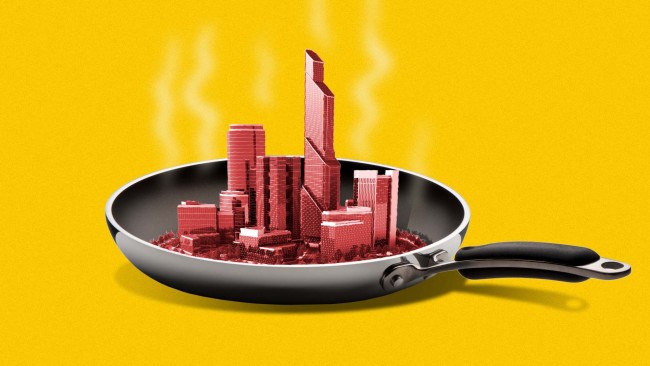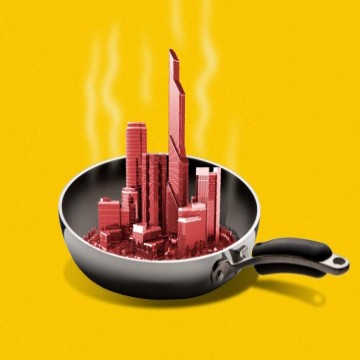Rising global temperatures wreak havoc on urban "heat islands"
Kim Hart

Most U.S. cities are at risk of experiencing extreme heat thanks to the "urban heat island effect" that's causing cities to warm as much as 50% faster than the rest of the country.
Why it matters: July was the hottest month ever recorded globally, and it was especially brutal for major metros.
"The extreme heat we’re seeing right now is the result of both climate change and urban development patterns. Cities have to think about the long-term implications of the changing environment."
— Katharine Burgess, vice president of urban resilience at the Urban Land Institute
The big picture: Severe heat wreaks havoc on cities' infrastructure, like electric grids, and presents serious public health risks.
City planners and developers are rethinking urban design to keep buildings and people cool as temperatures rise, according to a new report by the Urban Land Institute first shared with Axios.
- Extreme heat may be a material risk: Moody's, Fitch Ratings and S&P Global warned that credit ratings could take into account cities' strategies for dealing with climate change. That could significantly impact cities' ability to raise capital and finance projects.
- Midsized U.S. cities can expect about a 1% GDP loss by 2050 due to increased expenses and reduced growth associated with rising temperatures.
By the numbers: On average, cities are 2°F to 6°F warmer than their surroundings. Because they are covered with sun-absorbing pavement and rooftops, cities can be up to 22 degrees hotter than surrounding areas.
- Today, cities have on average 10 more extreme heat events per year than they did in the mid-1950s.
- Heat islands cause about 20% of the formation of urban smog, which then traps even more hot air in a city.
What's happening: From an economic perspective, cities that plan for super-hot futures may have a competitive advantage as consumers' preferences change with the weather.
- In Houston, a midtown throughway was narrowed to make room for 175 large trees to provide shade cover along the corridor, resulting in a 20-degree temperature reduction in shaded areas.
- In Scottsdale, a mixed-use development placed clustered buildings at specific angles to provide shade to each other and to pedestrian walkways. A giant custom shade was installed above the central plaza.
- In New York City, parking lots are being turned into green spaces and "cool roofs" are installed throughout the city.
- In Toronto, all buildings of a certain size are required by law to install vegetation on rooftops to reduce ambient temperatures. Greening 5% of the city's rooftop areas is estimated to lower citywide temperatures by about 1 degree.
- In Los Angeles, where 40% of the city is covered with pavement, roofing materials must meet new sun-reflecting standards, and some city roads are coated with light-colored, reflective coating.
The catch: Heat mitigation measures are expensive, especially for large-scale projects. In the near-term, increasing air conditioning will likely be the go-to cooling method, even though they give off heat that may increase local temperatures and, through emissions, worsen climate change.
The most intense daytime urban heat islands are Las Vegas, Albuquerque, Denver, Portland, Louisville, Washington, D.C., Kansas City, Columbus, Minneapolis and Seattle.
Threat level: The impacts of extreme heat are felt disproportionately by a city's most vulnerable populations — the homeless, elderly, young and those living in poverty. Low-income communities are also less likely to have air conditioning or access to pools or cooling centers.
The bottom line: Severe heat will force cities, especially those in already-warm climates, to find long-term cooling strategies to protect their people, infrastructure and economy.

